 |
| ‘A wide range of
aircraft were included in the program and the organisers had done
sterling work in getting representative types lined up for this
year’s event...’ |
A number of stars aligned in
mid-October to make the 2023 Duxford Flying Finale, the last
airshow of the UK season, something very special.
The
significance of the event, taking place 50 years to the day since
the very first Duxford Air Day, had not registered with me until
hearing about it at the Battle of Britain Airshow a month
previously. As I got out of my car, I paused to reflect on my own
Duxford journey which started a few months shy of my ninth
birthday on a family visit in 1983. It has, in fact, become a
regular part of both my life and now that of my two sons.
Therefore, as I walked over the footbridge from the north car park
and got my first glimpses of the array of warbirds lined up on the
flight line, I was stepping into the familiar embrace of an old
friend.
|
 |
 |
| |
|
 |
 |
| However, it is an old friend
that constantly surprises and this is perhaps one of the secrets
of Duxford’s attraction. Having a plethora of live warbirds and
restoration houses based there and visible means there is always
something new to see and the Flying Finale did not disappoint in
this regard. First off was the sight of one of the most
anticipated restoration projects that I can remember, namely
Fighter Aviation Engineering Ltd’s immaculate Hawker Tempest MkII
MW763/G-TEMT. Restored by Anglia Aircraft Restorations Ltd at
Sywell, the Bristol Centaurus powered beast had undertaken its
first flight just four days earlier in the capable hands of Pete
Kynsey, transiting to Duxford at the flight’s conclusion with
P-51D Mustang ‘Contrary Mary’ keeping station alongside. Seeing
the aircraft in the flesh in the crisp, bright October sunlight,
was something to behold and well and truly wetted the appetite for
next year’s display season. |
 |
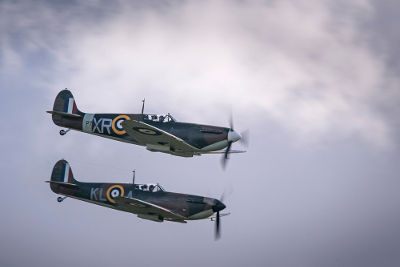 |
The second welcome
sight was another classic Hawker fighter in the shape of the
world’s only surviving Hawker Fury MkI biplane. Returned to the
skies in 2012 after an epic 20 year restoration, the machine had
not flown since 2019. With work completed by Vintage Fabrics and
Retrotec Ltd, Clive Denney took the unique aircraft aloft for a
local flight on October 8th and flew again on the morning of the
Finale as part of the ongoing test program.
Once the 1935
built Fury was back on the ground, there was a fleeting chance to
get a picture with a Hawker Hurricane in view before the Fury was
parked up next to Spitfire MkIX RW382 and the Hawker Tempest,
although it was a shame a Hurricane could not have been slotted in
as well. This line up showed the dramatic advances in technology
made in the twelve years between the respective Hawker prototypes’
first flights. |
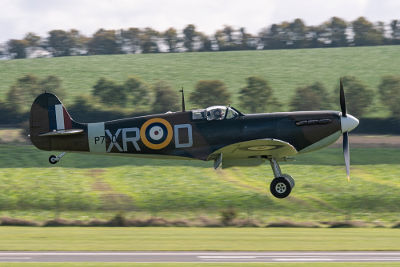 |
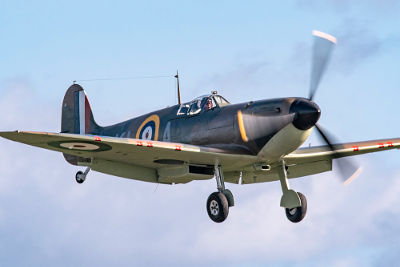 |
|
|
|
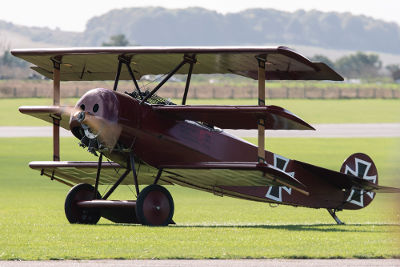 |
 |
|
Returning to the Flying Finale’s theme, we were reminded that the
1973 Air Day was not only the first Duxford airshow, but also the
first time the site had been open to the public. A wide range of
aircraft were included in the program and the organisers had done
sterling work in getting representative types lined up for this
year’s event, including one aircraft that had actually displayed
back in 1973. The line up was a mix of warbirds and aerobatic
displays, including some new teams, reflecting Duxford’s wide
appeal and its support of new acts and new pilots. |
 |
 |
|
First to take centre stage was Diana Britten MBE in her Mudry
CAP-232, opening the Finale with a precise aerobatic routine. This
was followed by a trio of warbirds in the shape of Fighter
Aviation Engineering Ltd’s Hawker Hurricane MkI P2902, flown by
Gabriel Barton, leading the Comanche Spitfires, MkI AR213 being
flown by Stu Goldspink with Mk.I X4650 piloted by Brian Smith. By
now, the dramatic cloudscape that would remain throughout the show
had filled the sky and it was an evocative sight to see a vic of
these classic fighters silhouetted against it. Of course, the
Spitfire and Hurricane are synonymous with Duxford, 19 Squadron
being based there when it became the first unit to be equipped
with Spitfire MkIs in 1938, while 310 (Czech) Squadron was the
first unit to fly Hurricanes from Duxford during the Battle of
Britain. |
 |
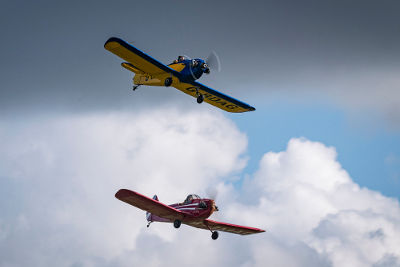 |
|
|
|
 |
 |
Next to display was Paul Ford in his Fokker Dr1 replica G-FOKK,
the guttural sound of the aircraft’s rotary engine contrasting
with the more refined notes of the preceding inline Merlins.
While piston powered warbirds are Duxford’s bread and butter,
there have been many jet displays over the years, ranging from the
Golden Apple Trust’s classic F-86A Sabre that was based at Duxford
for several years until its move to the US in 2014, to modern fast
jets, the USAF’s F-15E Strike Eagle demo in 2011 being
particularly memorable. As a nod to this, and to the appearance by
the RAF Gemini Pair team of two Jet Provost T5s at the 1973 Air
Day, Chris Heames displayed BAC Jet Provost T5A XW325/G-BWGF. The
aircraft is marked in the colours of 6 FTS, with which it spent
most of its service life, and Chris performed a dynamically fluid
routine, beginning by curving in from the M11 end, thin wisps of
vapour streaming from the aircraft’s wingtips in the turns. |
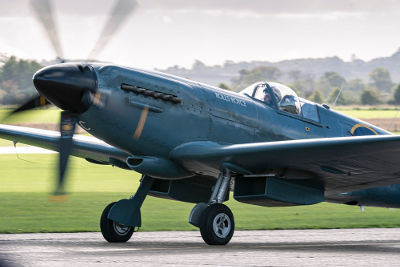 |
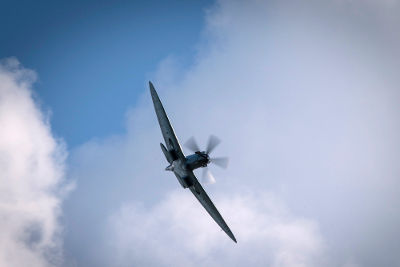 |
|
Plane Sailing have been a part of the Duxford
scene since 1985, first with Catalina G-BLSC and then, from 2004,
with Canadian built Vickers Canso G-PBYA marked up as a USAAF
OA-10A Catalina of the 5th Emergency Rescue Squadron, 8th
Air Force. The display was flown by John Harmsworth with plenty of
topside shown, much welcomed by the photographers in the crowd.
The light and cloudscape seemed to be at its best at this point
too making for some memorable images.
In stark contrast to the sight and size of
the Catalina were the two Taylor Monoplanes of the next act. The
Taylor Mono Display Team was formed earlier this year by 21 year
old Ben Gilmore and his friend Bruce Buglass. The diminutive size
of the aircraft made even the familiar D31 Turbulents of The
Turbulent Team look positively spacious in comparison and it was a
pleasure to see a new act fly a well executed and well received
routine.
|
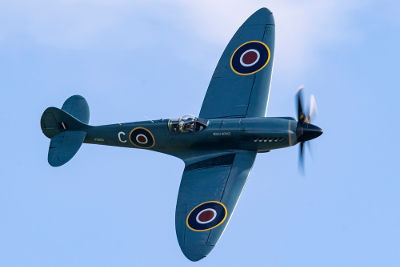 |
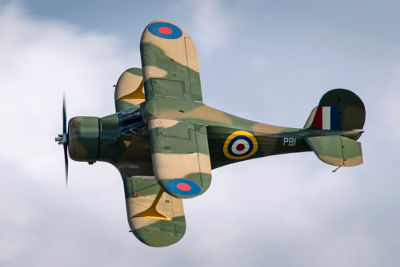 |
|
|
|
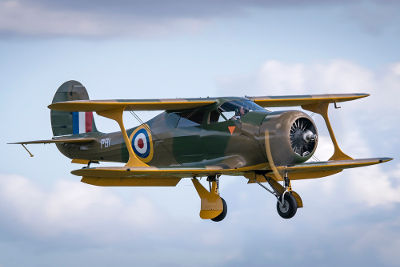 |
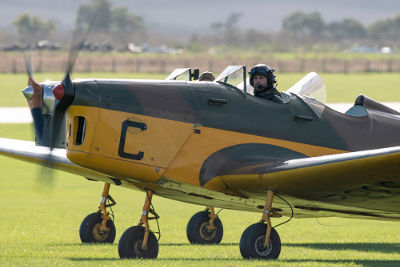 |
|
Aero Legends are a relative newcomer to the
warbird scene but have risen to become a well respected operator
providing many different flight experiences. However, while Aero
Legends itself was not around in 1973, their Douglas DC-3 Dakota
KP220 was, albeit in stripped down state on show in one of the
hangars. It would be 1977 before the aircraft was acquired by Air
Atlantique and brought back to airworthy condition. After a varied
career, the Dakota was then sold to Aero Legends in 2019 and was
displayed at the Finale by Andrew Dixon.
Joining the Dakota at the beginning of the
routine was Charlie Brown in Aero Legends’ Supermarine Spitfire
MkIX TD314/G-CGYJ. Some pilots have a certain style that, over
time, becomes recognisable. Having seen Charlie displaying
Spitfires many times, and even photographed him in this one air to
air, it was a welcome treat to see him showcase TD314 with due
aplomb in the Duxford skies.
|
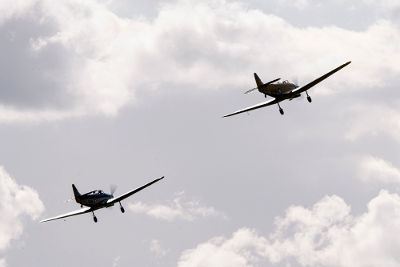 |
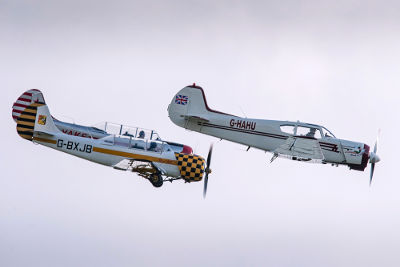 |
|
The next display was from another new act for
the 2023 season namely the Titans Display Team. This saw Patrick
Wilson and Simon Ansell piloting a high-wing American Champion
Xtreme Decathlon and low-wing XtremeAir XA42 in a sharp routine of
formation and individual aerobatics. This was all the more
visually appealing due to the eye catching blue and white colour
schemes on the aircraft and the use of white smoke.
|
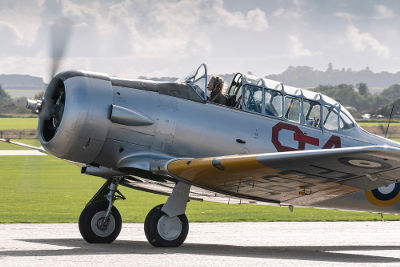 |
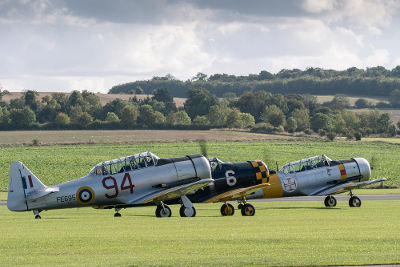 |
|
|
|
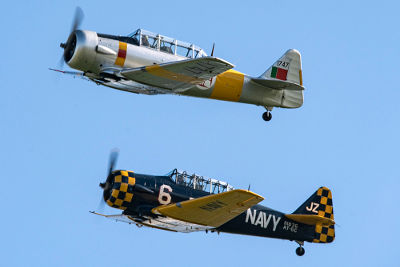 |
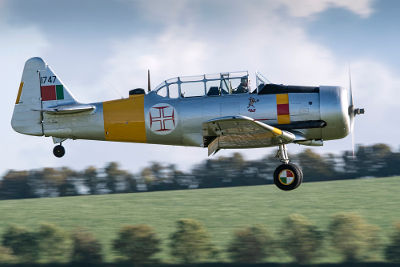 |
|
By now, we had seen three Rolls Royce Merlin
powered examples of the Spitfire and next it was the turn of a
Griffon powered example to display in the shape of the Rolls Royce
Heritage Flight’s (RRHF)
PRXIX PS853/G-RRGN flown by former Officer Commanding of the
Battle of Britain Memorial Flight, Squadron Leader Mark ‘Disco’
Discombe MBE. The Griffon entered service later than the Merlin
and had a larger capacity of 37 litres giving the opportunity for
more power. The real innovation was that the Griffon was only
slightly larger than the Merlin making it a viable proposition to
mate with the Spitfire airframe offering a potential dramatic leap
in performance. While a discussion of supercharger and engine
development is beyond the scope of this review, the Griffon 66
series, as used in the photo-reconnaissance Spitfire PRXIX, gave
the aircraft a superlative performance and allowed it to roam over
occupied Europe with virtual impunity. Mark’s energetic display
showed the raw power of the Griffon, the engine’s much louder
rasping growl apparent when compared to the Merlin. The RRHF also
lease a Merlin powered aircraft, this being North American P-51D
Mustang G-CMDK ‘Warhorse’ but unfortunately, pilot illness
prevented the aircraft from participating as well.
|
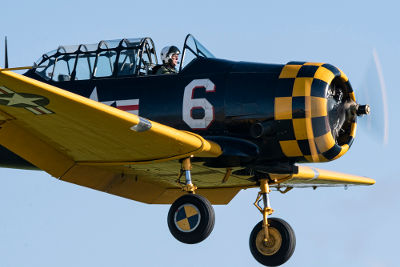 |
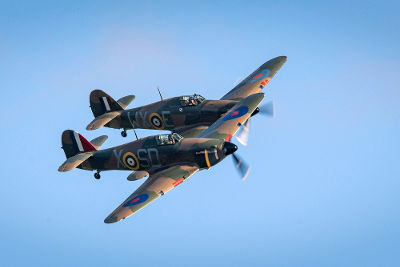 |
|
Once Mark had brought the Spitfire PRXIX back
onto the hard runway, it was the turn of Peter Kuypers to display
his lovely Beechcraft Staggerwing N18V. The prototype Staggering
first flew in 1932 and many were pressed into wartime service as
general hacks and this is reflected in the aircraft’s attractive
camouflage scheme. Peter, who is more likely to be seen at the
helm of B-17G ‘Sally-B,’ acquired the aircraft in 2021 to assist
with his commute from the Netherlands!
Following the
Staggerwing was the moment when we truly stepped back in time
fifty years as The Shuttleworth Collection’s Miles Magister
P6382/G-AJRS got airborne. This very machine displayed at the
first Air Day as well as the Collection’s Avro Tutor K3215/G-ASHA.
Unfortunately, although the Tutor had also been booked to display,
serviceability issues meant that its place was taken by a second
Old Warden based Magister in the shape of V1075/G-AKPF flown by
Dave Bramwell. With Jean-Michel Munn at the controls of G-AJRS, it
was an opportunity to reflect on how lucky we are to have such a
vibrant and long-lived historic aviation scene.
|
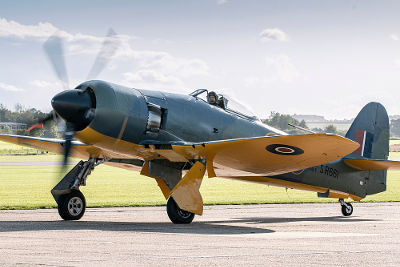 |
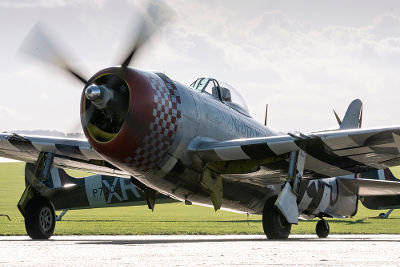 |
|
|
|
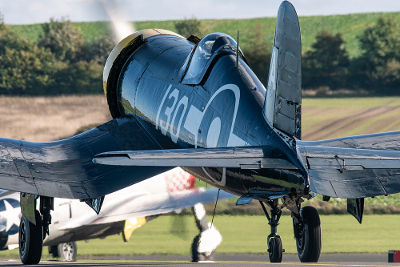 |
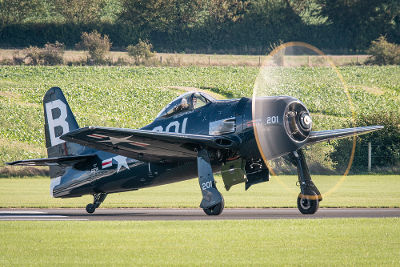 |
The show’s final formation
team act came next as The Flying Comrades took to the skies in
their Yak-18T and pair of Yak-52s piloted by Phil Hardisty, Alex
Lewton and Tom Turner. This is another relatively new team, formed
at the end of the Covid lockdown in 2021, and it was great to see
them displaying again at Duxford.
Next, we were treated to
the sight and sound of three Pratt & Whitney R-1340 radial engines
and their respective North American Harvards holding on the
Duxford grass as Rod Dean in G-BGPB and Nigel Wilson in G-TSIX
prepared for a pairs display to be followed by Isobel Rutland in
CK Aviation Services T-6 G-BTXI, an aircraft once owned by The
Fighter Collection (TFC). With the snarling rasp of supersonic
prop-tips reverberating off the Duxford hangars, the Harvards took
off with Rod and Nigel positioning for their formation routine.
Once completed Isobel ran in to make her air display debut with a
solo aerobatic performance. |
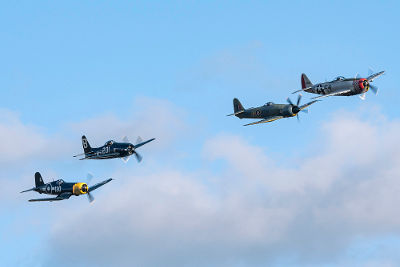 |
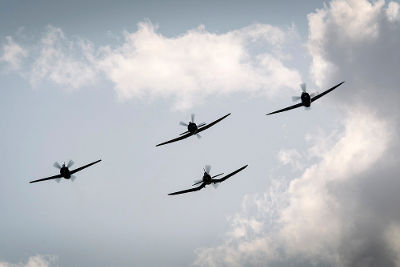 |
It was now time for warbirds
to take centre stage again as the Flying Finale geared up for its
grand finale. A trio of Hurricanes got airborne to fly a solo and
pairs routine. George Haye was first off in Hurricane MkXII
G-HURI. This aircraft has a long association with Duxford having
been based there since 1989, firstly under the stewardship of The
Fighter Collection and then, from 2002, under the ownership of the
Historic Aircraft Collection. The next two Hurricanes are more
recent restorations signifying how the warbird movement continues
to grow and evolve. Second to get airborne was Fighter Aviation
Engineering’s MkI P2902 with Gabriel Barton in command followed by
the Hurricane 501 syndicate’s MkI V7497 flown by Neil Oakman.
The stage was now set for the Finale’s homage to the history
of Duxford and its warbirds. While a plethora of Spitfires and
Hurricanes have taken to the skies recently, some as restorations
and some that could more appropriately be seen as recreations, it
is the unique and rare warbirds that have set Duxford apart over
the years, all based on the foundations of The Fighter Collection
and the Old Flying Machine Company and their pioneering founders,
Stephen Grey and Ray and Mark Hanna, legends that are sadly no
longer with us. |
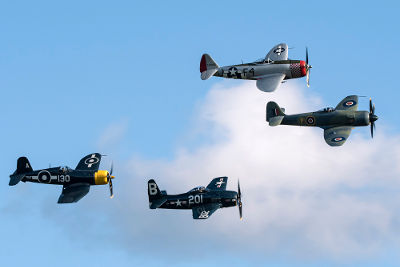 |
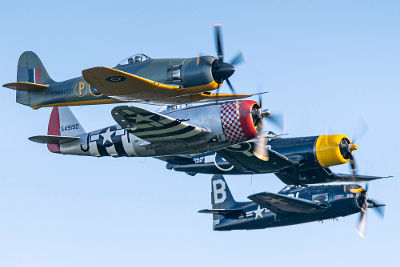 |
|
|
|
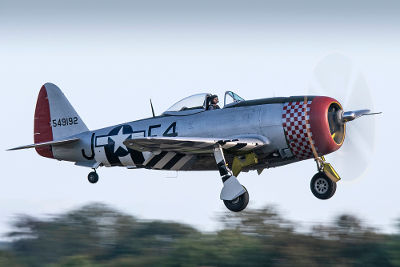 |
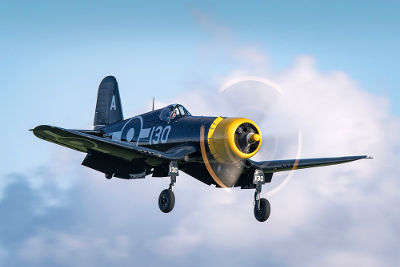 |
Taking to the skies were two stalwarts from The Fighter Collection
in the shape of Goodyear FG-1D Corsair G-FGID with Stu Goldspink
at the controls and TFC’s longest serving aircraft, Grumman F8F-2P
Bearcat G-RUMM with Brian Smith at the helm. The Corsair joined
TFC in 1986 but it was 1981 when the Bearcat joined what was to
become TFC. While these two warbirds represented Duxford’s
history, Fighter Aviation Engineering’s Hawker Fury ISS G-CBEL and
Republic P-47D Thunderbolt G-THUN, flown by Paul Bonhomme and
Steve Jones respectively, represented the new kids on the block
and the link to Sywell Aerodrome based Air Leasing which has fast
become the home of some very exciting and unique projects.
Led by Paul Bonhomme in the Fury, the quartet of fighters made
several formation passes before splitting into two pairs. The
Bearcat and Fury flew together, perhaps the ultimate piston
fighters built by America and England, while the Thunderbolt and
Corsair joined up as two types which gave sterling service in
World War Two. The quartet then reformed for one last pass before
breaking to land to close out what was an excellent show and a
wonderful way to commemorate and celebrate fifty years of air
events at this warbird mecca. |
|
|
|
Review by Andrew Critchell
|
|
